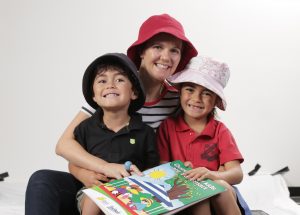Sunsmart schools – protecting from harmful UV rays

A few generations ago, sunburn was seen as a normal by-product of childhood fun, just like skinned knees and bumps on the head. As skin cancers plague the adulthood of those burnt babes, childhood sunburn has loomed as a serious health risk to Australians.
Australia’s sun is harsh, and when children are at school, daily Ultraviolet (UV) radiation levels are at their peak. This brings responsibility to schools, as well as a wonderful opportunity to engender sun smart behaviour as second nature.
The National SunSmart Schools Program was launched in 1998, and is offered in all primary schools nationwide. In Western Australia, where temperatures regularly reach 40 degrees Celsius in the summer, the program is gaining popularity in secondary schools. The Cancer Council provides support and tailored educational resources to schools, for improving the sun smart behaviour of their students.
Age appropriate lesson plans are available for download from www.cancer.org.au, complete with instructions and resources. The Cancer Council Australia website lists melanoma skin cancer as the fourth most commonly diagnosed cancer in Australia in 2012, and estimated that it will remain so in 2016. For more information on current and past statistics, please visit: www.melanoma.canceraustralia.gov.au
Childhood is the ideal time to change the culture of ‘tanned is beautiful’, and to promote a healthy approach to absorbing the sun’s rays in a responsible manner. While Vitamin D, which is absorbed through the skin from the sun, is vital for synthesising other vitamins and minerals, levels can be sufficiently obtained during the safer times of the day; early in the morning and later in the afternoon.
The difficulty, as stated on the Cancer Council’s website, is that the sun’s ultraviolet (UV) radiation is the major cause of skin cancer and the best natural source of vitamin D, which is needed for strong bones and overall health.
Bearing in mind that Australia is a large land mass with diverse climates and conditions, a policy that may suit schools in Broome will have little relevance in the chilly Tasmanian hills. Knowing the importance of Vitamin D for mood, energy levels and immunity, the Cancer Council recommends a balanced UV approach in order to reduce the risk of skin cancer, while ensuring some sun exposure for vitamin D. How this looks in the playground will vary from location to location, and schools will need to consider their own climates when developing policies.
The general guidelines across all states are the common goals of preventative care. The enduring campaign: Slip, Slop, Slap can be supported through measures such as, school uniform design, including wide brimmed hats, replacing athletics singlets with short-sleeved shirts and making a sunhat like a second skin during high UV months.
SunSmart schools also make a commitment to minimising exposure by increasing shade in outdoor playing areas, through shade sails, tree planting and playground design measures.

SunSmart school support in WA
Western Australia has long, hot and dry summers. For much of the school year, Western Australian students are playing, doing sport and learning in high UV periods of the day. Schools need not go it alone when creating a sun smart policy. While all states have access to sun smart policy and recommendations, The Cancer Council WA has these particular encouragements for SunSmart Schools membership.
From Cancer Council WA
If your school becomes a SunSmart School, Cancer Council WA provides you with the following FREE resources:
- a SunSmart sign
- a curriculum resource book
- advice on health promotion strategies including policy development
- access to educational resources
- SunSmart lesson guides and activities
- SunSmart talks to parents, staff and students.
Benefits of becoming a SunSmart school member include:
- Peace of mind – Cancer Council endorsement of your policy and procedures lets you know you have it right.
- Comprehensiveness – have you thought of everything? There is much more to sun protection than a ‘no hat no play’ rule.
- Access to accurate, current information on sun protection issues such as sunscreen allergies, nanoparticles, vitamin D, occupational safety and health and duty of care.
- Support – you get information about how other schools have dealt with particular problems, free teaching resources, access to competitions and discounts on sun protection items at the Cancer Council shop.
- Advocacy – Cancer Council speakers can talk to parents and staff about the risk of skin cancer and the value of good sun protection policies and procedures.
- Critical mass – formally joining the program allows Cancer Council to count your school in the program membership. In turn, higher participation rates add weight to our representations to the Department of Education, helps convince other schools to join the program and demonstrates your commitment to reducing the burden of skin cancer in the community.
State specific SunSmart guidelines
For information regarding SunSmart policy and support available in your state, visit http://www.cancer.org.au/preventing-cancer/sun-protection/sunsmart-schools/ .







